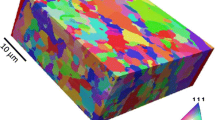Abstract
Three-dimensional (3-D) microstructural characterization has proven to be indispensable for the thorough understanding of the often highly complex microstructures studied in materials science. However, most 3-D characterization techniques of opaque materials such as metals and ceramics are destructive and therefore prohibit 3-D studies of the dynamic microstructural evolution processes. In this paper we describe two complimentary techniques capable of nondestructive 3-D characterization and provide examples of the application of these techniques to investigate microstructural evolution processes in metallic systems.
Similar content being viewed by others
References
M.V. Kral et al., “3-D Analysis of Microstructures,”Materials Characterization 2000, 45 (1) (2000) pp. 17–23.
L. Margulies, G. Winther, and H.F. Poulsen, “In Situ Measurement of Grain Rotation during Deformation of Polycrystals,”Science, 291 (2001), p. 2392.
S.E. Offerman, “Grain Nucleation and Growth during Phase Transformations,”Science, 298 (2002), p. 1003.
S. Schmidt et al., “Watching the Growth of Bulk Grains during Recrystallization of Deformed Metals,”Science, 305 (2004), p. 229.
G. Spanos et al.,Proc. 25th Risø Int. Symp. Mater. Sci., ed. C. Gundlach et al. (Roskilde, Denmark: Risø National Laboratory, 2004), p. 137.
G. Spanos, organizer, Viewpoint set no. 41 “3-D Characterization and Analysis of Materials,”Scripta Mater., 55 (2006).
D. Isheim et al., “An Atom-Probe Tomographic Study of the Temporal Evolution of the Nanostructure of Fe−Cu based High-Strength Low-Carbon Steels,”Scripta Mater., 55 (2006), pp. 35–40.
M.D. Uchic et al., “3-D Microstructural Characterization of Nuckel Superalloys via Serial-Sectioning using a Dual Beam FIB-SEM,”Scripta Mater., 55 (2006), pp. 23–28.
J. Alkemper and P.W. Voorhees, “Quantitative Serial Sectioning Analysis,”J. Microsc., 201 (2001), pp. 388–394.
J.E. Spowart, H.M. Mullens, and B.T. Puchala, “Collecting and Analyzing Microstructures in Three Dimensions: A Fully Automated Approach,”JOM, 55 (10) (2003), pp. 35–37.
P. Cloetens et al., “Hard X-ray Phase Imaging using Simple Propagation of a Coherent Synchrotron Radiation Beam,”J. Phys. D: Appl. Phys. 32 (1999), p. A145.
J. Baruchel et al., “Advances in Synchrotron Radiation Microtomography,”Scripta Mater., 55 (2006), pp. 41–46.
R.W. Fonda et al., “2-D and 3-D Analyses of Sigma Precipitates and Porosity in a Superaustenitic Stainless Steel,” submitted for publication toMet. Mat. Trans. A.
A.M. Talbot and D.E. Furman, “Sigma Formation and Its Effect on the Impact Properties of Fe−Ni−Cr Alloys,”Trans. ASM, 45 (1953), pp. 429–442.
H.F. Poulsen,3-D X-Ray Diffraction Microscopy. Mapping Polycrystals and their Dynamics (Berlin: Springer, 2004).
E.M. Lauridsen et al., “Recrystallization Kinetics of Individual Bulk Grains in 90% Cold-Rolled Aluminium,”Acta Materialia, 51 (2003), p. 4423.
N. Iqbal et al., “Real-Time Observation of Grain Nucleation and Growth during Solidification of Aluminium Alloys,”Acta Materialia, 53 (2005), p. 2875.
H.I. Aaronson et al., “Sympathetic Nucleation: An Overview,”Mater. Sci. Eng. B, 32 (1995), pp. 107–123.
R.W. Fonda et al., unpublished research (2006).
E.M. Lauridsen et al., “Tracking: A Method for Structural Characterization of Grains in Powders or Polycrystals,”J. Appl. Cryst., 34 (2001), p. 744.
H.F. Poulsen et al., “3-D Maps of Grain Boundaries and the Stress State of Individual Grains in Polycrystals and Powders,”J. Appl. Cryst., 34 (2001), p. 751.
H.F. Poulsen and X. Fu, “Generation of Grain Maps by an Algebraic Reconstruction Technique,”J. Appl. Cryst., 36 (2003), p. 1062.
S.F. Nielsen et al.,Proc. 21st Risø Int. Symp. on Mat. Sci., ed. N. Hansen et al. (Roskilde, Denmark: Risø National Laboratory, 2000), p. 473.
O. Hignette et al., “Efficient Sub 100 nm Focusing of Hard X-rays,”Rev. Sci. Inst., 76 (6) (2005).
Author information
Authors and Affiliations
Rights and permissions
About this article
Cite this article
Lauridsen, E.M., Dey, S.R., Fonda, R.W. et al. Nondestructive approaches for 3-D materials characterization. JOM 58, 40–44 (2006). https://doi.org/10.1007/BF02748494
Issue Date:
DOI: https://doi.org/10.1007/BF02748494




